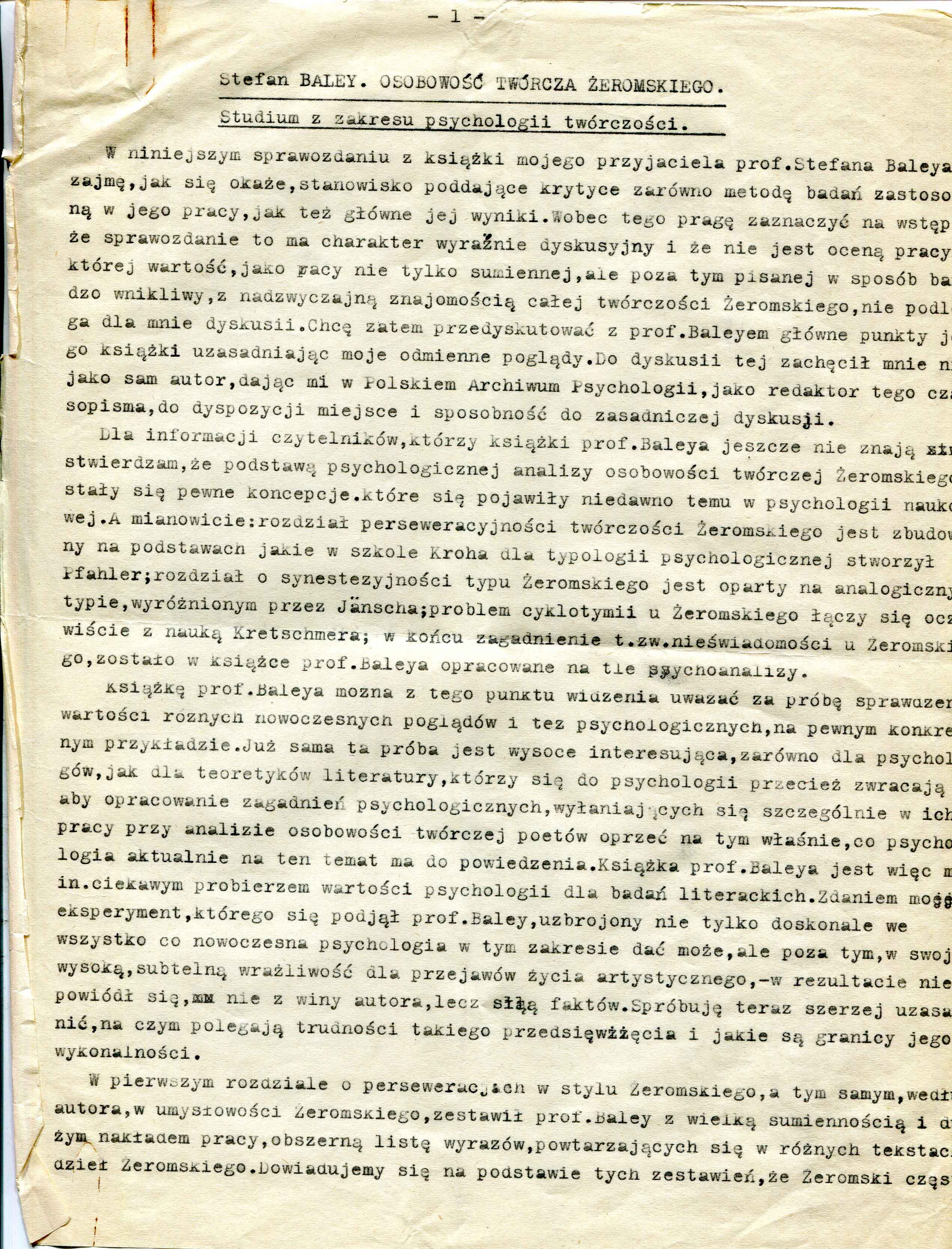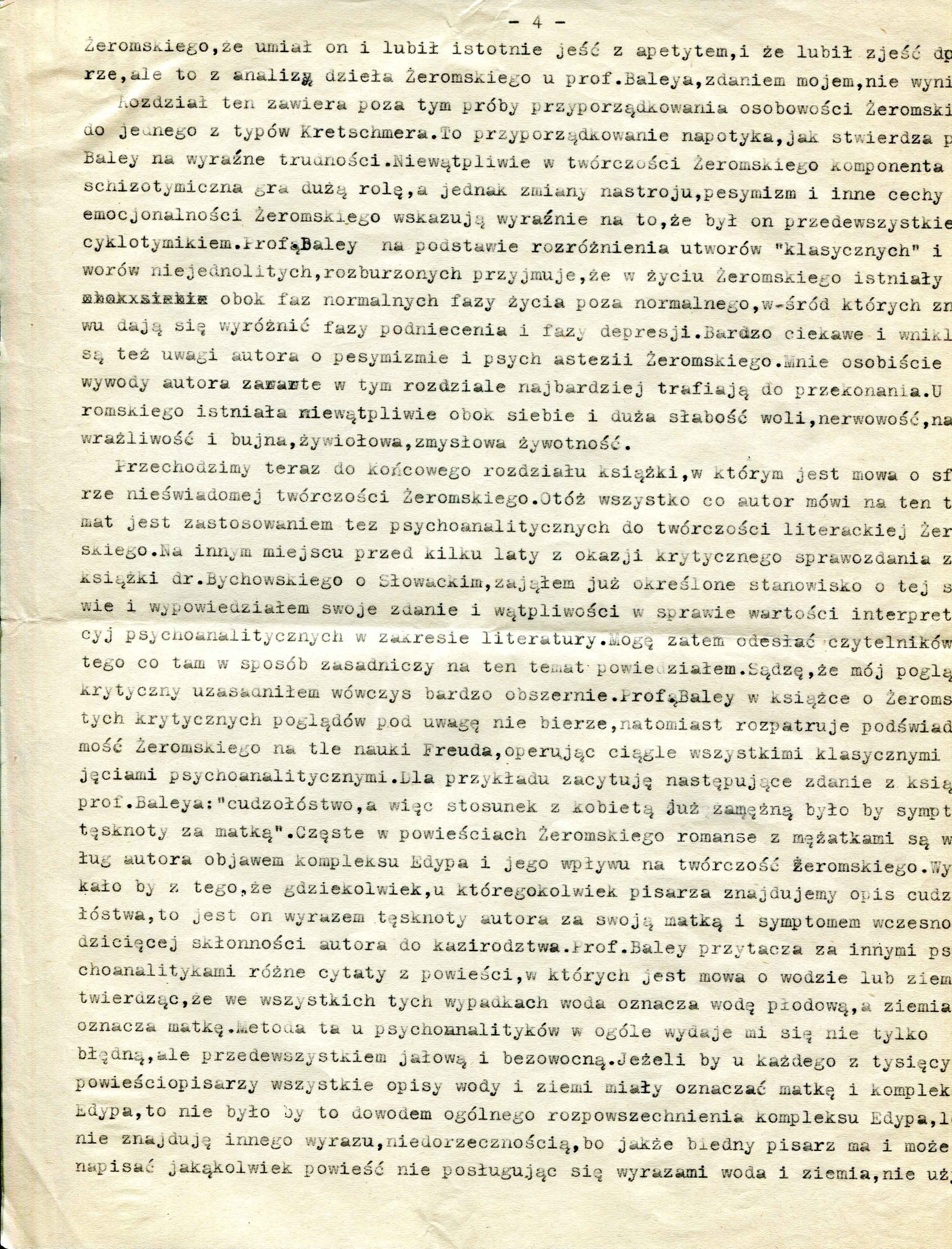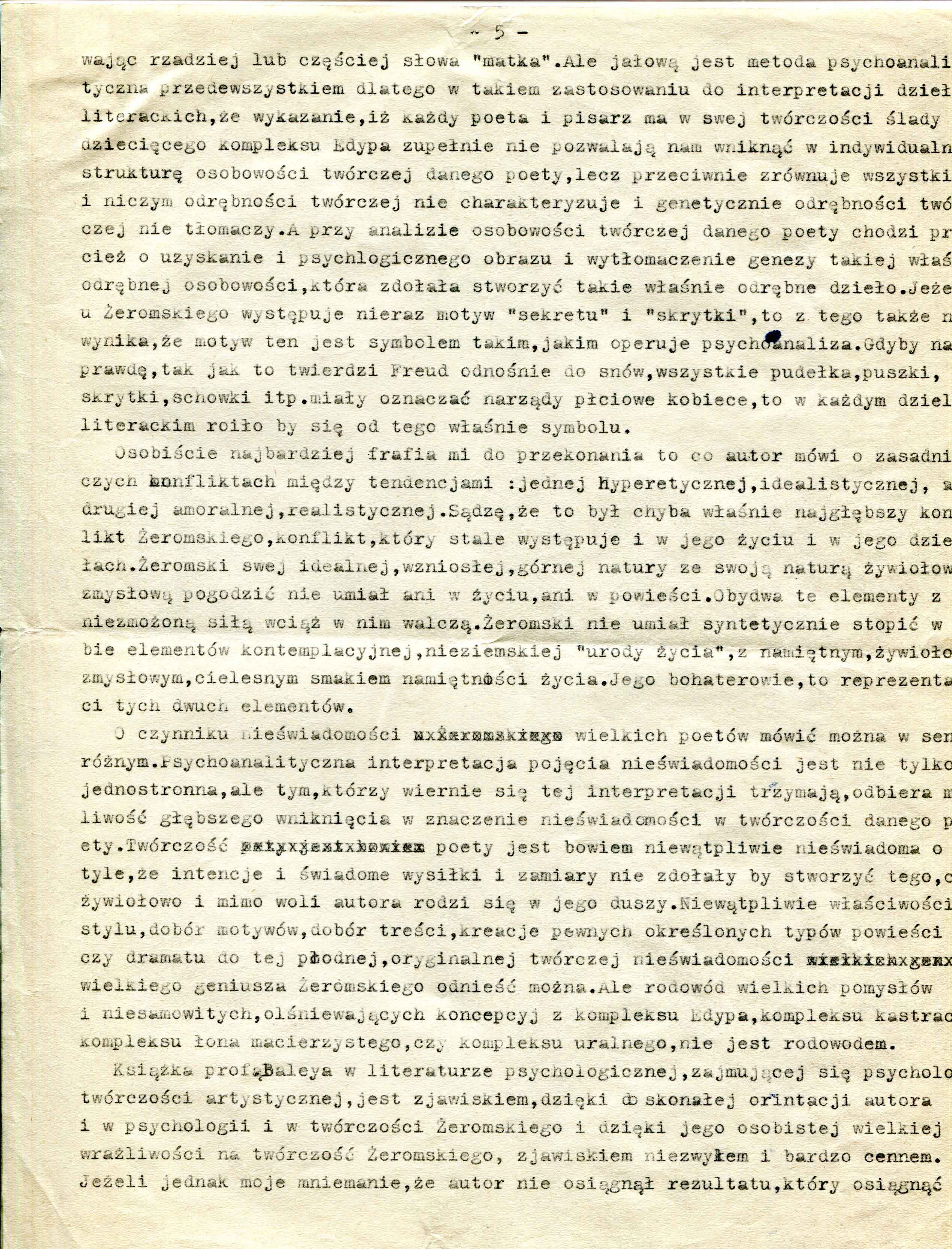





Stefan BALEY. CREATIVE PERSONALITY OF ŻEROMSKI. Study in the field of psychology of creativity.
Stefan BALEY. ŻEROMSKI’S CREATIVE PERSONALITY.
A study in the field of psychology of creativity.
In this a review of my friend’s, prof. Stefan Baley’s, book, as it turns out, I will take a stand that criticizes both the method of research used in his work and its main results. Therefore, I would like to stress that the fact the review is clearly controversial and that it is not a negative assessment of the work whose value, as a work not only conscientious, but otherwise written in a very insightful way, with an extraordinary level of familiarity of the entire body of work of Żeromski, is undebatable for me. Hence the objective is to discuss with prof. Baley the main points of his book justifying my differing views. I was encouraged by the author himself to enter into this debate when he, as the editor of the journal Polskie Archiwum Psychologii [Eng. the Polish Archives of Psychology], gave me space and opportunity for this fundamental discussion.
For information of the readers who are not yet famiiar with prof. Baley’s book as of yet, I would like to state that the basis of the psychological analysis of Żeromski’s creative personality were some ideas which have appeared recently in scientific psychology. Namely, the chapter on the perseverance of Żeromski’s work is built on the foundation that Pfahler created at Kroh’s school for psychological typology; the chapter on synthestetic character of Żeromski’s type is based on an analogous type distinguished by Jänsch; the problem of cyclothymia in Żeromski’s work is of course connected with Kretschmer’s teachings; finally, the issue of the so-called of the unconscious in Żeromski’s writings in the book of prof. Baley was developed in the context of psychoanalysis.
Prof. Baley’s work can from this point of view be considered as an attempt to check the value of various modern views and psychological theses on a specific example. This very attempt is highly interesting, both for psychologists and for theoreticians of literature who, after all, turn to psychology, which is especially noticeable in works on the analysis of creative personality of poets often based on what psychology currently has to say on the topic. The book by prof. Baley is therefore an interesting touchstone of the utilization of values in psychology for literary research. Hence I am convinced that the experiment undertaken by prof. Baley, equipped perfectly not only with everything that modern psychology in this area has to offer, but otherwise in his high, subtle sensitivity to the manifestations of artistic life, fails in the end not at the fault of the author, but because of certain strong factual evidence. I will now try to explain more extensively what the difficulties of such an undertaking and the limits of its feasibility are.
In the first chapter on perseverations in Żeromski’s style, and thus, according to the author, in Żeromski’s mind, prof. Baley has, with great conscientiousness, compiled an extensive list of words repeated in Żeromski’s various texts. From these sets we find out that Żeromski often repeats the same word two or three times, e.g. “Oh, nights, nights,” or “you are Laura, Laura, Laura.” There are also phrases and sayings some of which he cites literally, like “Woman, what have I to do with you?” Similarly, some expressions or motifs and objects repeat many times over. For example, an oriole is listed as appearing in various works, according to the list of prof. Baley, at least a dozen times. There are many places in Żeromski’s works where a rose is mentioned. Another common expression and favorite motif is that of “ash”. Żeromski also enjoys the expression and image of the “secret room”, “secret”, “mystery” etc. Prof. Baley also mentions “loneliness” as a separate repetitive motif. The aforementioned examples of repetition in Żeromski’s words and motifs are interpreted by prof. Baley as a symptom of the perseverance of Żeromski’s creative mentality.
The examples given by prof. Baley would be convincing, 1 /. if it was shown that the author does not repeat other words equally often 2 /. if it was shown that with other authors, who do not possess the characteristics of perseveration, such repetitions are not as frequent. Repetition is in fact a stylistic tool for various artistic purposes, e.g. to emphasize the meaning of an expression, to evoke the experience of monotony and constant rhythm in a reader, etc. As for the repetition of such words as “ash”, or “rose”, or “hiding place”, it would be necessary to prove the hypertrophic occurrence of such words or motifs in Żeromski’s work, which is only achievable by means of comparative statistics which include the works of other authors.
In a separate, interesting, chapter prof. Baley deals with with repeated events and situations as well as “doppelgangers”; the types of heroes from various novels that can be reduced to one type they all come from. Professor Baley shows that in the works of Żeromski seemingly different heroes of various novels or dramas are actually similar to each other, they are variations of the same person. Of particular interest have I found the study of the “advancements” of the characters in various novels, hence the broadly understood development of a character, so the previously unrealized implementation of features of the presented type in later works.
I think, however, that the repetition of motifs with their constant modification, that operating on the same types of characters in different novels in such a way that each novel develops and processes the type, experimenting with it in a way and tracking various life options of these types, is not a specific feature of Żeromski’s work, but that every novelist does and should do this: weak, third-rate writers, such as Karol May recycle their modest repertoire of types over and over again, great writers – such as Żeromski – create theirs always anew and find it a particularly entertaining artistic task to give the characters of their novels the possibility of full life beyond the limited frames of one novel.
By nature, each writer only has a limited number of human types they create, and their deep and essential creative ambition is just deepening and extracting from the character they had created everything that can live in it: the doppelganger method serves this very purpose. Prof. Baley’s thesis about perseverance as a feature of Żeromski’s characteristic creation has not been proved due to the drawbacks of the method. I am not saying that this element is not important in Żeromski’s work.
The second main feature of Żeromski’s work according to prof. Baley’s is its synesthetic character. Numerous examples show the reader that Żeromski often combines impressions belonging to different sensual domains, e.g. “fragrant taste” “lilac hymn”, “quiet poison”, “green death”. From this the author concludes that Żeromski experiences simultaneously with a number of senses, as someone who “while listening to a melody sees in a fantasy a series of gradually changing visual scenes”. But in this case too, one should clearly distinguish artistic and stylistic issues from psychological ones. The ability to combine words in such a way that the reader experiences a given sphere of sensations with several senses when the writer uses words from various sensory spheres, is a positive style property, a way of influencing the reader’s imagination in a way that certain experiences and fantasies become very concrete and vivid. Besides, you cannot forget that these fresh, new combinations of words and their corresponding sensations, such as “red sadness”, “metallic songs”, “wonderfully colorful scream” create new experiential values. With the help of this measure both the reader and the author are experiencing new realms of reality, and the creator of these sets not only expresses themselves in them, but creates them for a specific purpose.
In agreement with Jänsch, prof. Baley also includes personifications and further combining contrasts into the domain of synesthesia, e.g. “red-green panes”, “red-green moss”, “black flames”, “the spring smell of life”, “the breathtaking stench of death”. In this chapter the author also raises the issue of antitheses and ideological contradictions in Żeromski’s writings. As a result, in my opinion, the analyzed chapter does not evidence that Żeromski was the synesthetic type, because it was not proven that other authors do not write in a similar way, nor has it been shown that these properties of Żeromski’s style are an expression of his synesthetic experience, and not simply an original style property aimed to evoke certain specific effects.
In the chapter on Żeromski’s emotionalism I am not persuaded for example by the mention of the instinct of nutrition. According to prof. Baley “in Żeromski we can often see strong signs of a second animated instinct, namely the instinct of nutrition. The fact that Żeromski skillfully describes a good appetite, sybaritism, or gluttony of some characters in his various works, e.g. when Judym, despite the tragic situation, “ate a lot of chicken and lettuce with sour cream for supper” shows that he was able to describe in his novels the types of sybarites, gluttons when it was needed as part of the novel, and not that his “animal instinct made itself known.” When writing these words, I have found out from a person who knew Żeromski that, in fact, he knew how to eat with gusto and that he liked to eat well, but I am doubtful that prof. Baley’s analysis of Żeromski’s work could be treated as evidence of that.
This chapter also includes attempts to push Żeromski’s personality into the frame of one of Kretschemer’s types. As Baley says, this poses clear difficulties. Undoubtedly, the schizothymic component plays a major role in Żeromski’s writings, however the changes in mood, pessimism and other features Żeromski’s emotionality clearly indicate that he was above all a cyclothymic. Professor Baley, on the basis of the distinction between “classical” and heterogeneous, dispersed sets assumes that, apart from normal phases, phases of life beyond normal existed in Żeromski’s life, within which then one can also distinguish arousal and depressive phases. The author’s comments on pessimism and psychological astesia of Zeromski’s are also very interesting and insightful. For me personally the author’s arguments contained in this chapter are the most convincing. In Żeromski’s work one can definitely find both great weakness of will, nervousness or hypersensitivity and lush, spontaneous, sensual vitality.
We are now moving on to the final chapter of the book, which talks about the sphere of unconscious in Żeromski’s work. Everything the author says in this topic is the application of psychoanalytic theories to the literary output of Żeromski. A few years ago, while writing a critical review on a book by Bychowski on Słowacki, I have already expressed my opinion and doubts about the value of psychoanalytic interpretations in the field of literature. I can therefore refer the readers back to what I have fundamentally said there on the subject. I believe that I have justified my critical views very extensively at that time.
Professor Baley has not taken into account these critical views in his book on Żeromski, but instead examines the subconscious of Żeromski in the context of of Freud’s teachings, using all the classical psychoanalytic techniques. For example, I will quote the following sentence from prof. Baley’s book: “adultery, and therefore a relationship with a married woman would be a symptom of longing for a mother.” Affairs with married women, which appear often in the Żeromski’s novels, are, according to the author, a symptom of the Oedipus complex and its influence on Żeromski’s creations.
It would then mean that if any writer includes in their work a description of adultery, it is an expression of the author’s longing for their mother and a symptom of the author’s early childhood tendency for incest. In accordance with other psychoanalysts Professor Baley includes quotes from novels where there is talk of water or earth, claiming that in all these cases water signifies fetal water and earth signifies a mother. This method in psychoanalysts in general seems to me not only erroneous, but above all futile and fruitless. If among thousands of novelists every description of water and earth were to symbolize the mother and the Oedipus complex, it would surely not be proof of the widespread Oedipus complex. For lack of a better word I think it is an absurdity, because how is a poor writer supposed to write any novel without ever talking about water and earth, or using the word “mother”.
But the psychoanalytic method is futile when applied to the interpretation of literary works mainly because showing that every poet and writer possesses traces of childhood Oedipus complex does not allow us to penetrate into the individual structure of the creative personality of a given poet, but, on the contrary, makes everyone the same and does not help characterize creative separateness in any way, nor does it explain creative separateness in a genetic way. And when analyzing the creative personality of a given poet, it is all about obtaining a psychological image and explaining the genesis of such a separate personality that managed to create a given a separate work. The fact that the motifs “secret” and “hiding place” appear in Żeromski’s works does not mean that their significance is the same as in psychoanalysis. If it really were as Freud claims with regards to dreams, that all boxes, cans, lockers, etc. were to signify female sexual organs, then every literary work would be full of those symbols.
Personally, I am most convinced by what the author says about the fundamental conflicts between tendencies: one hyperethical, idealistic, and the other amoral, realistic. I think that this might have quite probably been Żeromski’s deepest conflict, one that constantly shows up in his life and in his works. Żeromski could not reconcile his ideal, sublime, lofty nature with his vital sensual nature, neither in his life nor in his novels. Both of these elements still battle each other with unrelenting strength. Żeromski was not able to synthetically melt together the elements of contemplative, unearthly “beauty of life” with the sultry, vital, sensual, physical taste of the passion of life. His characters are representative of these two elements.
The unconscious element of the works of great poets can be talked about in various ways. The psychoanalytic interpretation of the concept of the unconscious is not only one-sided, but those who faithfully follow this interpretation take away the possibility of deeper penetration into the meaning of the unconscious in the output of a given poet. The work of a poet is undoubtedly unconscious as far as the fact that intentions and conscious efforts and would not have been able to create that which is spontaneously and involuntarily born in the author’s soul. Undoubtedly, one can relate the features of the style, the choice of motifs, the choice of content, the creation of certain specific types of novels or drama to this fertile, original, creative unconscious of the great genius Żeromski. But the lineage of great ideas and amazing, dazzling concepts of the Oedipus complex, the castration complex, or the oral complex, is no lineage.
Prof. Baley’s book is a a wonder in psychological literature dealing with artistic psychology, thanks to the the author being perfectly versed both in psychology and in the work of Żeromski, as well as his personal great sensitivity to Żeromski’s creative spirit, an extraordinary and valuable wonder. If, however, my conviction that the author did not achieve the result which he intended to achieve is right, then I think that, apart from the misgivings of the methods used I tried to demonstrate, regarding the need for comparative analyzes of style, motifs, construction, etc. of literary works, most of all, the lacking psychological foundations based on which the author built the analysis of the creative personality of Żeromski.
According to Pfahler, perseverance is almost always the core and basic innate personality trait, but the image of Żeromski’s personality in view of this characteristic shows that it is not a very significant feature. The same applies to the characteristics synestesis. It seems to me that not much will be learned about a given individuality and we will not be able to penetrate deeply into it when we analyze it as Jänsch’s synestetic type either. After all, the image of creative personality in the context of Freud’s science will always seem like a reflection in a distorting mirror, which creates not only a strange caricature, but also enlarges some details of the features, while the others are diminished because of some unknown curve non-existent in reality.
So this is how my discussion prof. Baley’s book unfolded. I hope that distracted readers will not, on the basis of my review, come to believe that I do not appreciate its value. Before planes were built, which then rose into the air and were able to stay there for extended periods of time, a number of machines that could not leave the ground was constructed first. But these machines were also a result of very focused efforts and an extraordinary invention – they were a necessary intermediate link.
Stefan Szuman.
